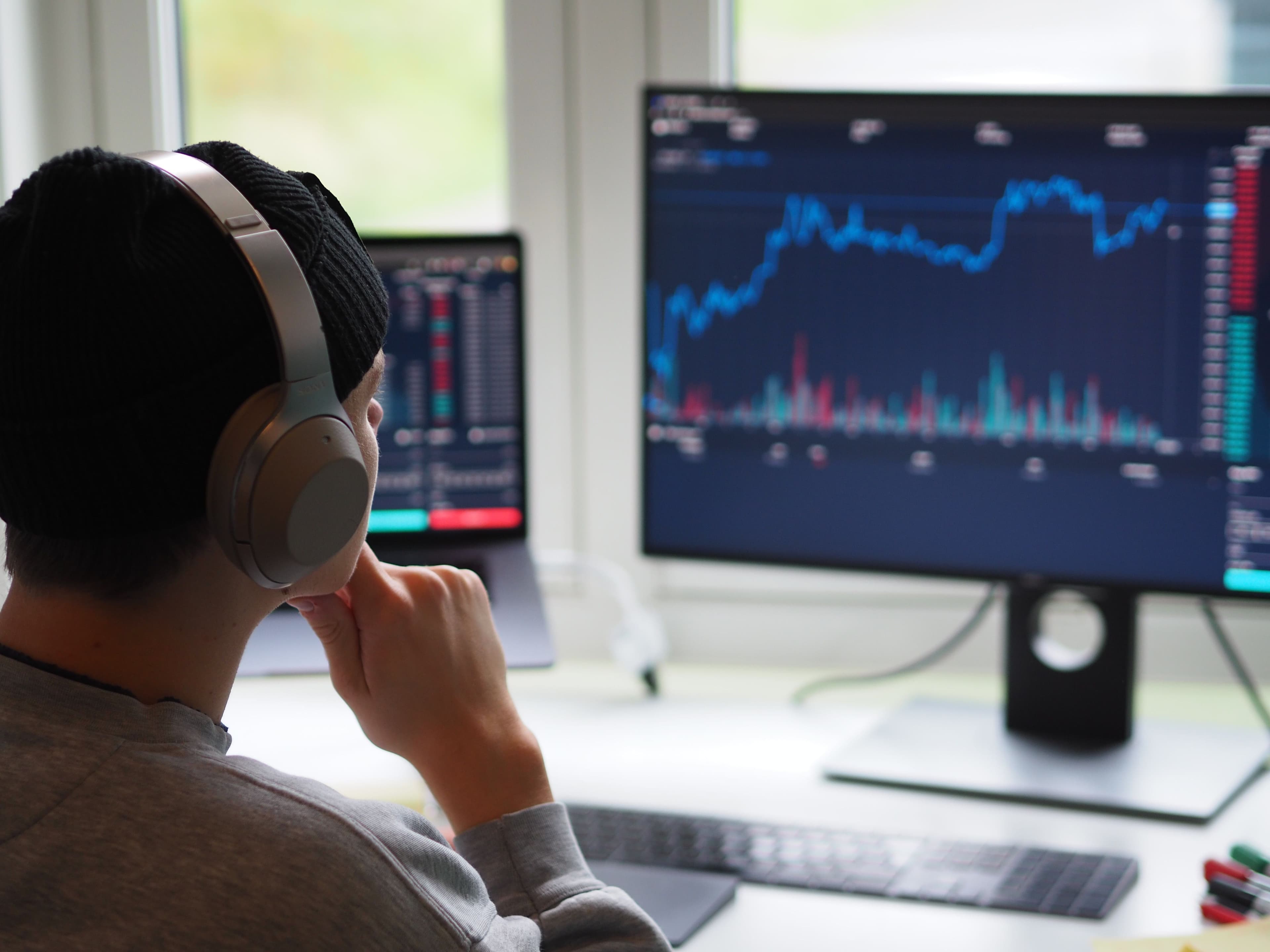
What is crypto trading?
The large price swings in cryptocurrencies can tempt many people to start trading, and if you know what you’re doing, it is possible to make good money. But what’s important to keep in mind when trading actively?
What is trading, and how does it differ from investing?
The very first thing we want to emphasize is that only you can know which investment strategy suits you best – whether that’s long-term investing or active trading.
Active trading means carrying out frequent purchases and sales of, for example, cryptocurrencies or stocks. This is in contrast to traditional investing, where the goal is to earn money over the long term.
Traders take advantage of price fluctuations and often make several transactions in a single day. That’s why traders need to actively monitor the market, while investors are less concerned with daily volatility and more focused on long-term price development.
Some strategies in active trading
There are many different approaches to active trading, and here are some of the most common:
- Scalping: A short-term trading strategy. Positions are held for very brief intervals – seconds or minutes – to capture small price movements during the day.
- Day trading: In day trading, several positions are opened and closed within the same day, based on price changes.
- Swing trading: Positions are held for several days or even weeks, depending on how the price develops during that period.
Beating the crypto market
The goal of trading is to “beat the market” – in other words, to earn more than you would by simply investing and holding over time. Traders who succeed usually have deep knowledge of the market and trading strategies, and they stay on top of the news cycle. It’s also important to remember that you’re competing against some of the best traders out there, which means the likelihood of losing money is high. For that reason, it helps to have some capital set aside.
And you’ll also need a good dose of luck. Even the most experienced trader has bad days.
Many who take on too much risk may lack knowledge. But there are also highly knowledgeable traders who willingly take on bigger risks because they’re comfortable doing so.
Once again, it often comes down to luck and chance – and whether you can afford to rely on your own gut feeling and analysis. Other qualities that can be useful for a trader are discipline and the ability to keep a cool head. It’s important not to get carried away emotionally, even when the market is highly uncertain.
“The advantage of long-term investing, compared to trading, is that you can ignore the ups and downs that affect the market in the short term. Those swings can otherwise be both frustrating and time-consuming to analyze.”
Get inspiration from experts – but don’t copy them
Lucky or not, as a beginner in cryptocurrency and trading, knowledge is still power. But where should you turn to find the knowledge you need to succeed?
Get inspiration from experts – but don’t copy them. When it comes to investing and trading, you should choose what fits your personality, your risk appetite, and your time horizon.
A beginner in cryptocurrency is stepping into a complex universe with as many opinions as there are experts. Understanding the fundamentals – both what cryptocurrency is built on and how the market works – is absolutely essential for becoming a successful trader.
Read up on the basics of crypto, such as key concepts and technologies. This will make you better equipped to understand the technology and distinguish between different currencies. Each cryptocurrency has different goals and purposes.
For example, the idea behind Bitcoin was to create a decentralized digital currency that would eliminate the need for a central authority or third party. Ethereum, on the other hand, while also used for sending and receiving funds globally, was designed to enable developers to build and publish smart contracts and decentralized applications.
Be critical of influencers
It’s also wise to be critical of whom – and what advice – you choose to follow. Many influencers may appear to be experts in their field, but recent cases have shown that several of them are still beginners themselves.
A “finfluencer” – short for financial influencer – is someone with a large following on social media who shares tips on personal investing. As they say in the crypto world: DYOR (Do Your Own Research).
That said, social media and other channels can still be extremely valuable. They can help you stay updated and connect with like-minded people. Even though you should never blindly copy others, you can find plenty of good discussions and interesting reading material to help you learn more about what you’re involved in.
What does it take to trade actively?
As we’ve already mentioned, knowledge, experience, and discipline are fundamental if you want to trade at a profitable level. On top of that, you’ll need time.
Some argue that trading is a full-time job, and even those who trade as a hobby must be prepared for the fact that it’s time-consuming and may take priority over other commitments.
As noted earlier, traders often rely on specific strategies and tools that give them an edge over others. Technical analysis, for example, is a useful method when trying to identify tops and bottoms in the crypto market.
Technical analysis involves looking at past price data in order to predict future movements and decide when and what to invest in. Traders study how prices have developed over time, often in relation to technical indicators. The aim is not to find a definitive answer, but to identify trends that are typical – or atypical – compared to past outcomes.
There is rarely a fundamental reason behind the daily or weekly fluctuations. Traders who base their decisions on technical analysis are looking for the patterns that cryptocurrencies often follow. You can almost be sure that thousands of other traders have drawn the same trendlines you have – and that is often the reason why technical analysis can identify support and resistance levels that many rely on for their decisions.
Should you trade actively?
As mentioned above, active trading requires both time and energy. Does it really pay off for most people? Probably not. Still, research shows that about 25 percent of day traders make money, so it’s definitely possible.
The same research also shows that the human brain often overestimates gains and underestimates losses. Several small profits that a trader makes during the day are often wiped out by larger losses – sometimes without even noticing it. This makes it confusing and difficult to keep track of whether you’re actually gaining or losing overall.
Most day traders give up
Around 85 percent of all day traders quit within three years. Finding a balance between active trading and long-term investing may be the key to avoiding that fate.
Two of Firi’s own employees, software developer Ronny and data scientist Aleksander, both have experience with active crypto trading.
“I trade less often now than before, but I still make exceptions and try to outsmart the market by timing my buys and sells. Risk-adjusting my positions has saved me from many losses. If I have the time and see something that looks obvious, I’ll take the chance,” says Ronny.
He also suggests having multiple accounts to separate trading from long-term investments. In addition, Ronny keeps his trades below a certain amount to minimize the risk of large losses.
Aleksander has also reduced his trading, as it sometimes demands more time and energy than he has available – but he still follows the market closely.
“I see a clear advantage in being active while also investing for the long term, as it gives you the chance to limit potential losses. If you see the market dropping, you can try to sell in time. And when the value starts rising again, you can buy back in,” he explains.
You should also keep in mind the costs of frequent trading. Any fees or commissions, currency surcharges (if you use international exchanges), and taxes on gains should all be factored in when deciding whether active trading is right for you.
Trading – in short
Active trading can be lucrative for experienced traders, and while it can be both fun and educational, it requires a lot of knowledge, experience, and capital. Most people who try it give up within a few years – which is why it’s crucial to study the subject thoroughly before you begin.
If you feel ready to give it a try, you can sign up with MitID at Firi. Of course, you don’t have to trade actively either – many people simply buy and hold cryptocurrency, a strategy known as HODL (Hold On for Dear Life). And many have found success with that too.
Remember: buying and selling cryptocurrency involves high risk, and historical returns are never a guarantee of future results.
